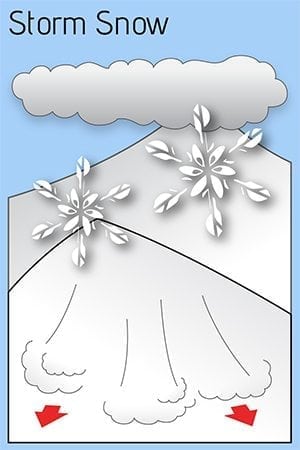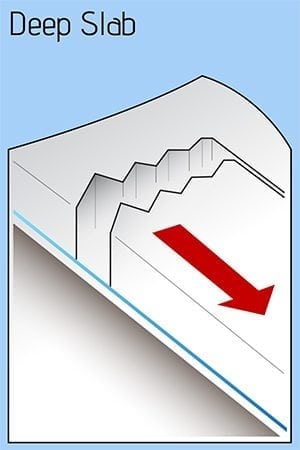Valdez
Above 3,000ftModerate
1,500 to 3,000ftModerate
Below 1,500ftModerate
Degrees of Avalanche Danger
Avalanche Problems
Problem 1
Decreasing temperatures along with accumulating snowfall coming to an end has allowed the most recent storm snow to settle to a degree. Human triggered avalanches will be possible today up to 3 feet in depth. North winds are forecasted to increase to moderate today. The most likely place to trigger an avalanche will be in steep convex terrain or in areas where active or recent wind loading has occurred. In the Maritime zone the 1/25 rain crust exists below 2500′ and has been losing strength, creating a potential weak layer. Human triggered avalanches are possible at that interface. Otherwise the new snow/old snow interface is currently our main concern.
The weather prior to the latest storm (overcast skies, light snowfall and mild temperatures) was not favorable to form facets (weak snow) at or near the surface in most areas. This will allow the storm snow to bond well with the snowpack once given ample time. Very little natural avalanche activity was observed with this storm which increases our confidence in a lack of a persistent weak layer at the new snow/old interface. DOT mitigation efforts were able to produce several D2-2.5 avalanches within the storm snow at the tail end of the storm. No step downs were observed.
Even a strong snowpack has flaws, in addition our forecast area is vast, diverse and stability may vary from place to place. It will be important to pay attention to how well the new snow snow has bonded and recent wind loading in the area that you choose to travel today. Watch for signs of instability such as shooting cracks, collapsing or recent avalanche that would indicate unstable conditions.
Likelihood:
- Almost Certain
- Very Likely
- Likely
- Possible
- Unlikely
Size:
- Historic
- Very Large
- Large
- Small
Trend
- Increasing
- Steady
- Decreasing
Problem 2
Weak snow continues to exist near the base of our snowpack in all three climate zones. This weak snow has recently been under increasing pressure as heavy snowfall and strong winds occurred 2/5-7. The last recorded avalanche activity at this layer occurred during the 1/23-25 storm on Nicks Buttress / ~3500’/ north aspect (see avalanche activity section). The amount of snow and wind our area just received was significant, and was a great strength test of weak snow near the base of our snowpack. No avalanches have been observed that failed or stepped down to this layer during the latest storm. Human triggered avalanches are currently unlikely to occur that fail on weak snow near the base of our snowpack.
Faceted snow near the ground has been found to vary significantly from place to place. In most locations this snow has been found to be rounding (gaining strength) and unreactive in stability tests. In thin areas of the snowpack these facets are significantly more developed. The most likely places to affect weak snow near the ground will be in areas where the snowpack is thin.
If you find it is possible to push a ski pole to the ground in areas you travel. Assume that a weak faceted snowpack exists in that location, that could act as a trigger point.

Depth hoar from Nicks Buttress ~4000′ North aspect 1/31.
Likelihood:
- Almost Certain
- Very Likely
- Likely
- Possible
- Unlikely
Size:
- Historic
- Very Large
- Large
- Small
Trend
- Increasing
- Steady
- Decreasing
Avalanche Activity
Below is a summary of observed Avalanche activity from the last 7 days. Avalanches that were noted earlier in the season can be viewed by clicking the link below.
If you trigger or observe an avalanche consider leaving a public observation.
2/7- DOT avalanche control work on 2/7 produced several D2-2.5 avalanches. All of these appear to have failed at the new snow/old interface without any step downs observed. Avalanche activity mostly occurred in the mid elevation band 3500′-4000′ on the Buttresses of RFS, Cracked Ice, and Python. The most significant results occurred on Berlin Wall at ~5000′ with a crown that looks to exceed 2 meters. This was likely due to significant wind loading during the storm.
Very little natural avalanche activity was observed.
Weather
Check out our updated weather tab! A collection of local weather stations are available for viewing with graphs and tabular data included.
NWS Watches and warnings
NONE NWS Point forecast for Thompson Pass
Date Thursday 02/09/23 Friday 02/10/23 Time (LT) 06 12 18 00 06 12 18 00 06 Cloud Cover OV OV FW FW FW OV OV OV OV Cloud Cover (%) 95 85 15 5 25 90 95 100 100 Temperature 11 13 9 2 -2 9 16 22 22 Max/Min Temp 15 -2 16 16 Wind Dir NE NE NE NE SE SE E E SE Wind (mph) 14 17 13 6 5 12 17 12 12 Wind Gust (mph) 27 32 27 23 34 Precip Prob (%) 5 0 0 0 0 40 70 90 90 Precip Type S S S S 12 Hour QPF 0.00 0.00 0.04 0.17 12 Hour Snow 0.0 0.0 0.6 2.8 Snow Level (kft) 0.0 0.0 0.0 0.0 0.0 0.0 0.0 0.4 0.4
Click on link below for Thompson Pass weather history graph:

| Date:
02/09 |
24 hr snow | HN24W* | High temp | Low temp | 72 hour SWE* | February snowfall | Seasonal snowfall | Snowpack Depth |
| Valdez | 1 | .05 | 31 | 16 | 1.65 | 37 | 182 | 64 |
| Thompson pass | 1 | – | N/O | N/O | N/O | 52 | 341 | 62 |
| 46 mile | Trace | – | 19 | 2 | N/O | 13 | ~80** | 48 |
*HN24W- 24 hour Snow water equivalent in inches
*SWE– Snow water equivalent
**46 mile seasonal snowfall total begins December 1st.
Additional Information
Click on the link below for a running summary of the seasons weather history.
Announcements
The avalanche hazard is moderate at all elevations. Human triggered avalanches are possible up to 3 feet in depth. North winds are forecasted to increase to moderate today creating the possibility for human triggered avalanches in specific locations. The most likely areas to trigger an avalanche will be on the lee side of high elevation ridge lines, and the lee side of wind channeled terrain. Watch for signs of instability such as shooting cracks, collapsing and recent natural avalanche activity.
Posted by Gareth Brown 02/09 8:00 am.
For a description of current avalanche problems, weather information, season history and more click the (+ full forecast) button. Avalanche forecasts will be issued Wednesday-Sunday.
If you have pictures of recent natural or human triggered avalanches or notice signs of instability such as shooting cracks or collapsing, leave an observation to help improve forecast accuracy.

